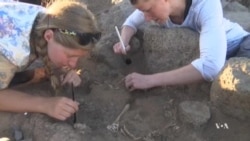New findings by archeologists excavating a prehistoric site in Jordan may shed new light on the way early humans transitioned from hunter-gatherers to farmers. But the discoveries also reveal the dramatic consequences of ancient climate changes.
Driving through arid, barren lava fields in Jordan’s Black Desert, it is hard to imagine that about 14,000 years ago, this was the area where humans started a revolutionary transition - from hunting and gathering to farming.
University of Copenhagen archaeologist Tobias Richter, who leads the excavation, says findings made so far show that after the last Ice Age, there was much more water here than there is today.
“When people appeared to have started to settle here, this would have been an extensive wetland area with birds, with lots of wetland plants that we found in the excavation, water fowl, herds of gazelle, of wild ass, of onager, roaming around this landscape. One can imagine it perhaps a little bit like the Serengeti in Africa," said Richter.
At this site, close to the Syrian border, scientists have found evidence that the area was occupied by a large number of humans who may have decided to stay because of the abundance of animals suitable for hunting.
Researchers think the lush richness of the land is also why the hunters eventually decided to settle down and begin farming.
Stone artifacts, along with bones of a child and an adult found nearby, may help scientists piece together a story about the lives of Neolithic humans - what plants and animals they grew and how they interacted within their social groups.
The project’s finds coordinator, Erin Estrup, shows off an ancient stone pestle, evidence that these early farmers grew seed pods and many other crops.
“We can then identify different species of plants which in turn will tell us what sort of things were growing out here. It's hard to imagine right now because it's all desert, but back many, many years ago, it was actually really nice and very, very green, and we can tell that from these plant remains," said Estrup.
On the environmental side, the dramatic transition from lush green steppes to now barren rocks in this part of Jordan is also strong evidence, scientists say, that climate changes occurred in the past and may happen in the future.





